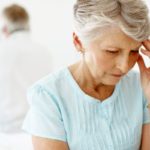Osteoporosis requires some extra caution when it comes to sex, but it doesn’t mean the end of intimacy.
Osteoporosis is a disease where increased bone weakness increases the risk of a broken bone. This condition affects men and women, although it is more common in women. In the United States about 10 million people have osteoporosis.
What are the causes and symptoms of osteoporosis?
Bone is living tissue that is constantly being broken down and replaced. Osteoporosis occurs when the creation of new bone doesn’t keep up with the removal of old bone. The bones can become so weak and brittle that even mild stresses such as bending, twisting or coughing can cause a fracture. Bones that commonly break include the vertebral bodies of the spine, the forearm, and the hip.
Signs and symptoms:
- Back pain
- Loss of 1-2 inches of height
- A stooped posture
Risk factors:
- Your sex: Women are much more likely to develop osteoporosis than men
- Age: The older you get, the greater the risk
- White or Asian descent
- Family history of a parent or sibling with osteoporosis
- Body frame size: Smaller men and women have a higher risk because they have less bone mass “in the bank” to draw down as they age
Lifestyle choices:
- Weight-bearing exercise and activities that promote balance and good posture are beneficial for your bones. Inactive people have a higher risk.
- Excessive consumption of alcohol increases your risk of osteoporosis
- Smoking plays a role in osteoporosis
Hormones, aging and osteoporosis
Hormones deserve special attention because lowered levels weaken the bones. The reduction of hormones in women at menopause is one of the strongest risk factors for developing osteoporosis. In fact, that is the major reason doctors recommend hormone replacement after the menopause, not simply to treat hot flashes and night sweats, but to keep the bones strong.
- Although less abrupt, men also experience a reduction in testosterone as they age.
- Treatments for breast cancer that reduce estrogen levels and for prostate cancer that reduce testosterone accelerate the normal bone loss of aging.
- Long-term use of corticosteroid medications such as prednisone and cortisone interferes with the bone-rebuilding process and increases the risk of developing osteoporosis.
Concerns about sex with osteoporosis
People diagnosed with osteoporosis, and their partners, have many questions:
- Is my (our) sex life over?
- I have already had a fracture; can I break another bone having intercourse?
- Can I hurt my partner with osteoporosis by having sex?
You do need to be careful so that you won’t damage any bones or experience pain during sexual activity. However, your sex life does not have to end because of osteoporosis.
Sex and intimacy can actually help relieve the pain of osteoporosis. Just like with arthritis, making love might be “just what the doctor ordered.” Orgasms release endorphins, the body’s natural pain relievers and mood elevators. (Think of the “runner’s high.”) The muscle stiffness sometimes associated with osteoporosis is also relaxed with the release of endorphins.
Strategies for maintaining a healthy sex life with osteoporosis
If you are careful and take a few simple precautions you can continue to enjoy this important part of life. The consistent theme of X’s and O’s is that a healthy sex life improves overall health.
1. Communicate with your partner
Talk, talk, talk with your partner. Communication is the not only the key to safe and comfortable sex but also to enhancing the intimacy of the relationship by sharing problems and concerns. Make sure you communicate any limitations ahead of time. That will help you both feel more confident and safe.
2. Be aware of your limitations
If there are areas where you or your partner experience pain or weakness, especially in the spine or joints, you need to take special care to avoid pressure to these areas. This may involve avoiding certain positions (more on that in a bit).
The severity of you or your partner’s condition is a factor in how you have sex with osteoporosis. Bone loss ranges from a simple deficiency (called osteopenia) to severe mineral loss that results in bone fragility and possible fractures.
Your doctor can perform tests to determine the severity of the disease and your fracture risk. Talk to your doctor about your concerns and your desire to maintain a healthy and safe sexual life.
3. Choose safer sexual positions.
There are some sexual positions that are safer for osteoporosis than others.
- Avoid any positions that cause pain or pressure. Communicate any discomfort to your partner. If there is pain, stop and reposition, or try another time if need be.
- The partner with osteoporosis, usually the woman, should be on top. If she is on the bottom the pressure on her hips could lead to a hip fracture. Being on top also gives her more control over positioning and body movement.
- Have you heard of spooning? This is one of the least strenuous sexual positions, with both partners on their sides and the man facing his partner’s back.
- Try using pillows, cushions or bolsters. They aid in positioning and offer extra comfort and support.
- Ask your doctor or physical therapist about positions that will be safest for your specific condition.
4. Explore other forms of intimacy beyond intercourse.
You don’t always have to have intercourse to give each other pleasure. See our article on ‘outercourse’ for ideas. Explore new avenues of sexual pleasure—you’ll likely be pleased by what you discover!
- Think about taking a toy to bed. Orgasm takes more stimulation to reach with aging. Vibrators and stimulators help avoid prolonged stimulation and uncomfortable positioning.
- Take a warm bath or shower together. Heat soothes the stiffness and pain and being naked together gets you in the mood.
- Remember that intimacy doesn’t just happen in the bedroom. Hold hands. Cuddle on the sofa as you watch TV or read. Hug and kiss. All of these will help you feel close to your partner and are good for the health of your relationship and your overall wellbeing.
What is the take home message?
Sex and intimacy are important elements of a relationship. You can continue to enjoy this wonderful part of life with precaution, planning, and common sense. Talk with your partner and healthcare provider. You will be able to have a fulfilling love life despite osteoporosis.
This article is part of our series on chronic illness and sexuality. We’d like to hear from you what topics you’d like us to cover. Let us know on our Ask the Experts page.
As per our Terms of Use, this article is for general educational and informational purposes only and is not meant to serve as a substitute for professional medical advice. Consult with your own physician or health care practitioner regarding the use of any information received here before using or relying on it. Your physician or health care practitioner should address any and all medical questions, concerns, and decisions regarding the possible treatment of any medical condition.
References
Banks, Yvonne, Osteoporosis and sex
Bates, Michael MD, Arthritis and sexuality
Flores, Pam, Sexual intimacy and osteoporosis
Myers, Wyatt, Osteoporosis and your sex life
Mayo Clinic Staff, Osteoporosis
Osteoporosis, https://en.wikipedia.org/wiki/Osteoporosis
Osteoporosis, www.patientresource.com/Osteoporosis.aspx





